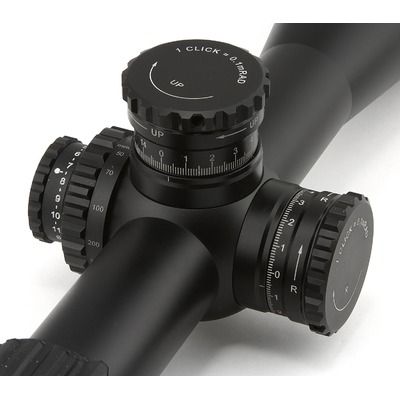I’ve had the opportunity to utilise one of the new Steiner Tactical 4-16x50 scopes for a few months now, so I thought I would do a brief write up.
Initial impressions when you first handle one is that its a monster of a scope and feels quite robust in both construction and function. The Military/Tactical line of riflescopes is Steiner Optik’s entry into the tactical riflescope market released in early 2012, solely focused on the tactical precision shooter. It would seem that the brains trust at Steiner Optik have done their research and identified the critical requirements of the tactical precision rifleman as well as those features of the market leaders in tactical optics such as Schmidt and Bender PMII and a Zeiss Hendsolt that have put them at the top of the apex and packaged it together.
The 4-16x50 is the mid range optic in the Steiner line with 3-12x, 3-15x and 5-25x magnification ranges available, each being identical in external appearance and features.
For more specifics have a browse through the Steiner webpage : www.steiner.de/military/rifle-scopes/04_telescopic-sight-tactical-4-16x50.php
For a great indepth comparison of the Steiner and other market leaders in tactical optics in the same utility range check out Illya's write up here: http://opticsthoughts.com/index.php...s-part-3&catid=4:rifle-scope-reviews&Itemid=4
Initial Observations
Like the majority of todays high end tactical optics the Military/Tacticals are a 34mm tube, and feels quite solidly constructed weighing in at around 970g. The 4-16x50 is quite a long scope, at 41cm long which in perspective is around the same length as the S&B PMII 5-25x56. There is quite a vast amount of tube length in the 4-16 with approximatly 9cm from the ocular to the turret box and 7cm from the turret box to the objective lens angle, providing ample linear movement for gaining an optimum eye relief. This may however also be a concern for those that utilise a Clip on Night Vision Device (CNVD) as the overall length may inhibit the mounting on all but the longest of forward rails such as a full length picatinny railed fore end etc.

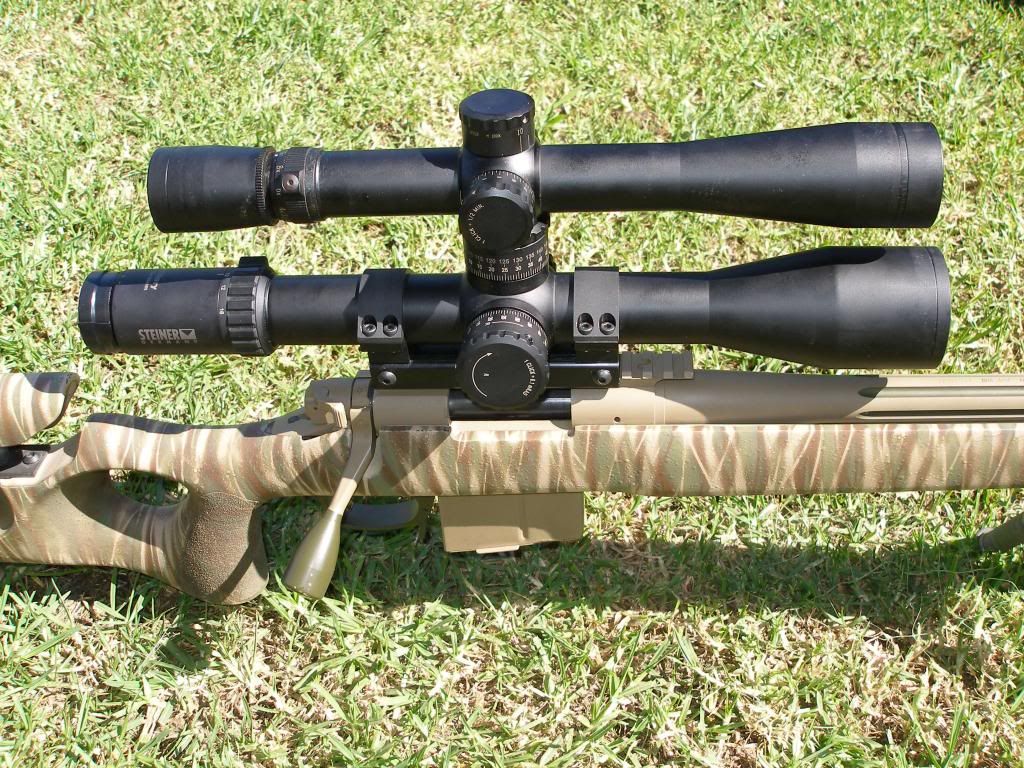
Here you can see the size comparison with a Leupold Mk4 3.5-10x40. I should have taken a comparison photo with a PMII 3-12x50 as a closer comparative example however like this whole review/write up idea it was an afterthought and that was all I had on hand.
Controls
The most obvious and attention grabbing feature once you get beyond the overall size are the turrets. As I stated earlier they are monstrous in size with deep machined flutes at the top edge which provides a positive grip for both gloved and bare hands allowing an easy grasp in all conditions. With a total of 32.5 Mrad of internal adjustment, The elevation turret allows for two clockwise revolutions of well marked laser etched .1 Milliradian (Mrad) adjustments in quite precise and definitive clicks, with 10 Mrad of elevation adjustment for the first revolution, and a further 9.5 Mrad on the second rotation for a total of 19.5Mrad of available internal elevation adjustment. The elevation turret features a solid zero stop precisely at the 0 hash mark, as well as visual and dexterous multiple turn indications, the most notable of which is the small ‘double turn indicator’ button the protrudes from below the Elevation turret once it is rotated to the 9.7 Mrad increment. The second revolution doesn’t complete a full 10Mrad due to the design of the zero stop pin and cam for the dual turn indicator button.
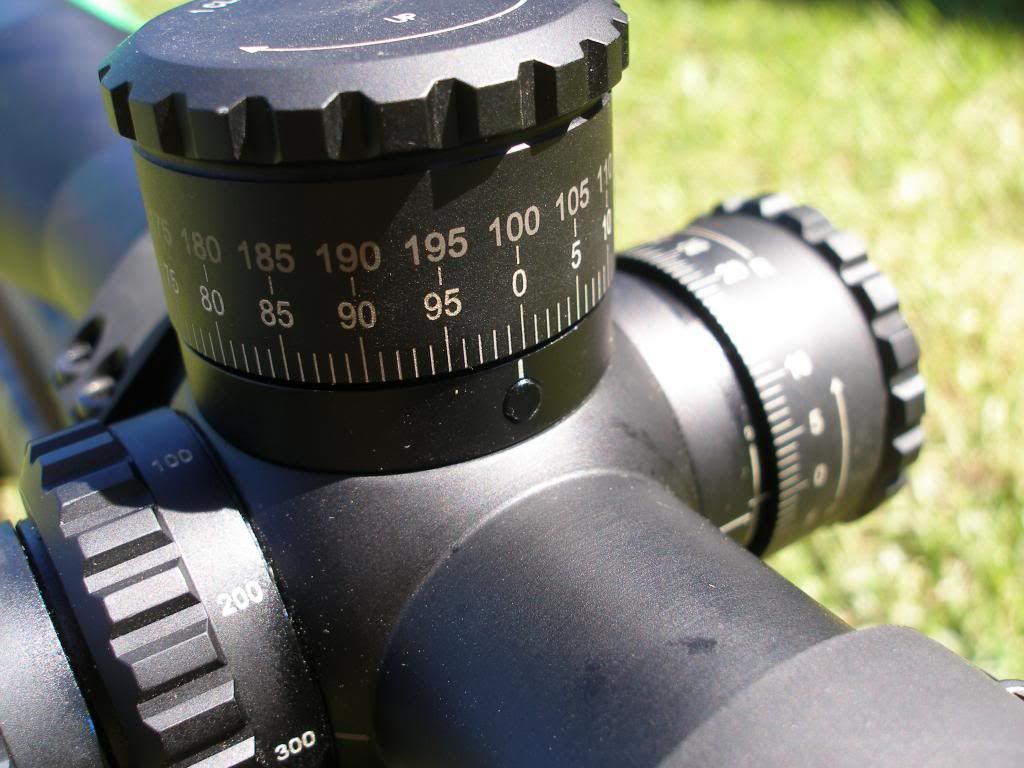
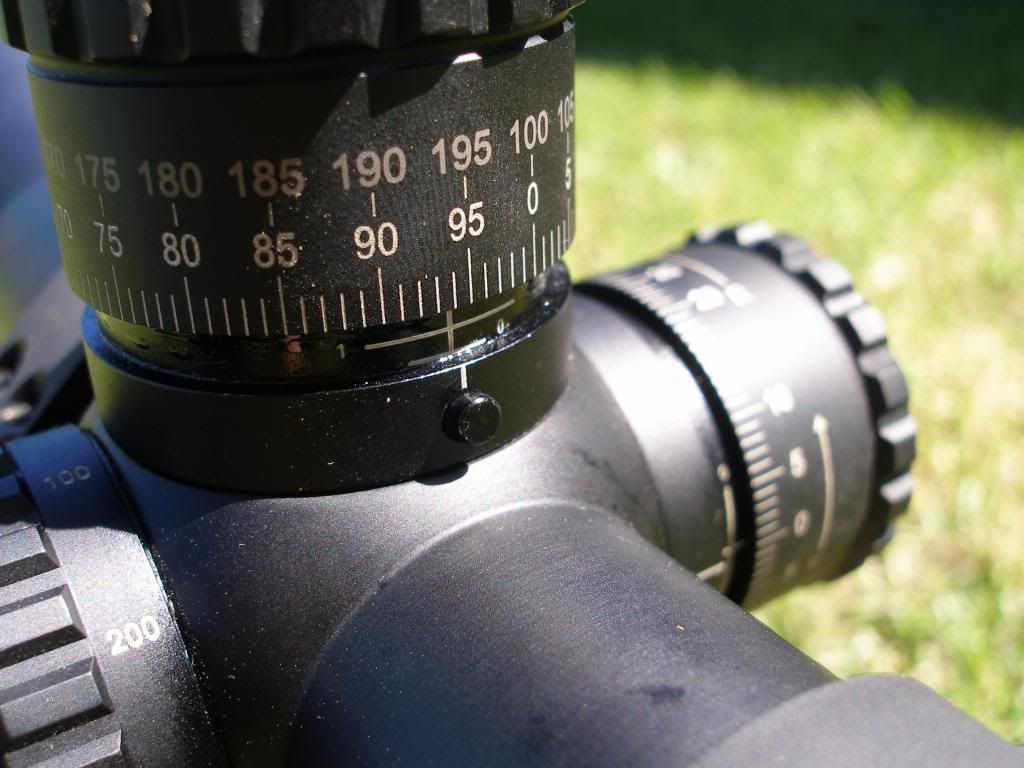
Multi Turn visual indicators as well as the spring loaded button protruding.
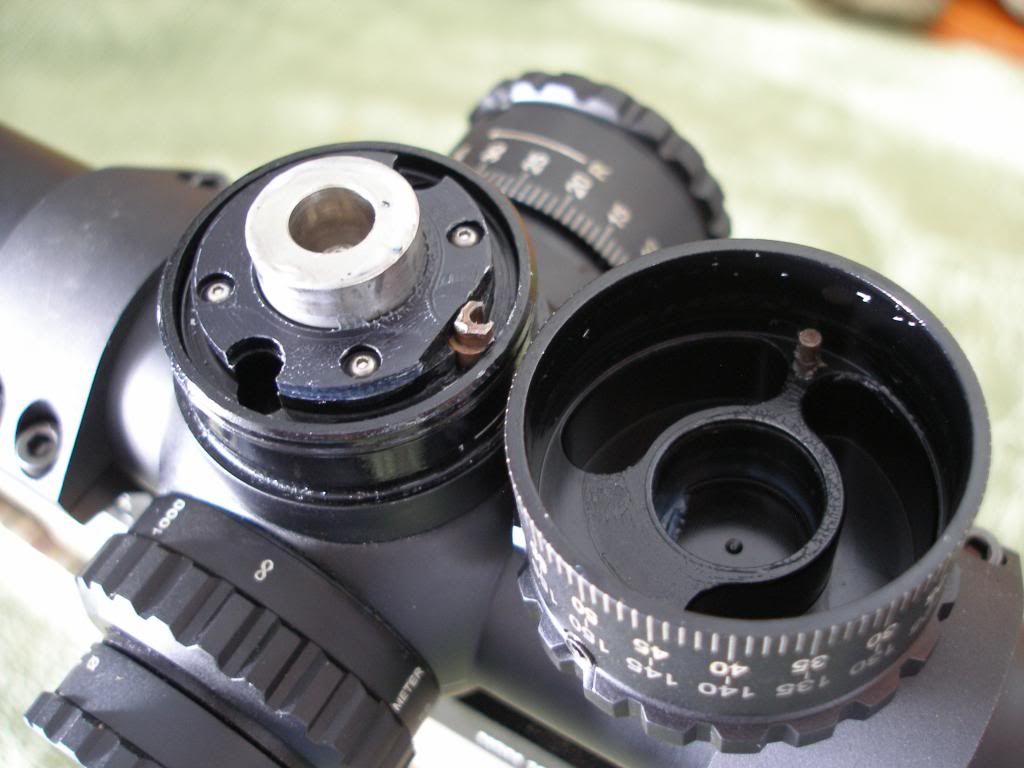
The elevation turret Internals showing both the double turn cam and the pin inside the turret. As it rotates through its second revolution the pin engages the cam rotating it clockwise allowing the turret to continue through its rotation. I noticed adjustments became slightly stiffer while rotating through this range; my guess is due to the slight force required to cam the button out under spring tension. Not a big deal and barely noticeable as it was still a smooth motion, but noticeable all the same.
The Windage turret is identical in both size and adjustment as the elevation turret, positive crisp .1 Mrad increments marked with both hash marks and numbers at every.5 Mrad. The turret provides 5.0 Mrad of total adjustment in both direction until it comes to a definitive stop. The windage turret is also fitted with a visual multi turn indicator so as to identify how much of the internal lateral adjustment has been used to enable your firearm zero.
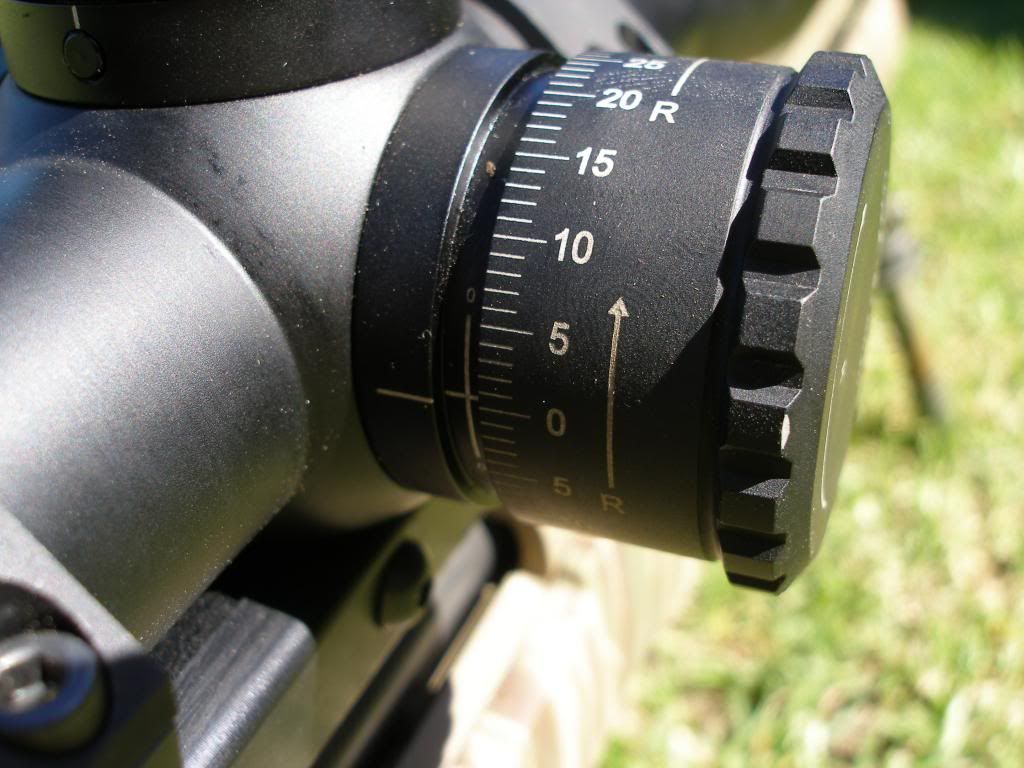
The parallax drum, like the Ziess Hendsolt also houses the rheostat for the Illuminated reticle, the parallax is numbered from 50m and then in 100m increments to 1000m and infinity. It was stiff yet smooth to rotate through its full range, providing a secure setting so as not to be easily or inadvertently adjusted form it required setting.
The rheostat and battery housing is a separate smaller turret housed outboard of the parallax drum and allows for 11 brightness settings illuminating the full Fine portion of the reticle. There is an ‘off’ increment in between each brightness enabling a quick switch on/switch off motion as opposed to rotating through the turrets full range of movement, which I one features of the Steiner I like a lot. Brightness settings 1-7 are very light so as to be used in conjunction with a CNVD, while settings 8-11 are daylight visible settings. I did notice that in lowlight conditions there was a degree of blooming and secondary reflection in the tube when using the 9-11 brightness settings, but this was only evident in lowlight. No blooming was observed during daylight conditions.

The magnification adjustment is controlled by a rubber coated ring forward of the ocular housing, it too features the large grippy blocks of the other turrets as well as a raised triangular grip block at the 8x position to aid in rotation. The magnification, like the parallax was stiff yet smooth to adjust through its 180 degree range, a feature Steiner has obviously identified as the middle ground of not easy/ not to tight to aid in any unwanted or inadvertent adjustments. There was no tunnelling of the FOV observed throughout the magnification range.
Reticle
The reticle is positioned in the 1st Focal Plane and is what Steiner have labelled the G2B mildot reticle, which like the Gen 2 Mildot combines the conventional mildots with .5mrad hash marks spaced in between each mildot at the .5 mrad interval. The reticle also has a 2 Mrad hash mark in the thick outer reticle posts at the 10Mrad mark. The reticle is a solid crosshair with a thickness of .06 Mrad, which at 16x is in my opinion on the thick side as it covers smaller targets at distance, in comparison to the P3F and P4F S&B reticles at .03Mrad. The crosshair thickness is on par with the its competitors and is perfectly suitable for the optics intended purpose, however those more inclined to shoot groups may find this thickness less appealing. The reticle and the elevation/windage adjustments tracked and performed faultlessly under a number of exercises, returning to zero after each evolution.
The optical clarity of the Steiner is what one expects of the high end riflescopes, and it is from my eye equal to the S&B PMII’S, good clarity and resolution, however I did notice that the eye box was more forgiving for eye relief and head placement at 12x than at 16x. A yellow ring was also present around the outside edge of the FOV, it was present throughout the magnification range however was most obvious at 16x. Again the usual apologies as these reticle pictures were taken with a handheld point and shoot camera behind the scope so they aren’t the greatest.
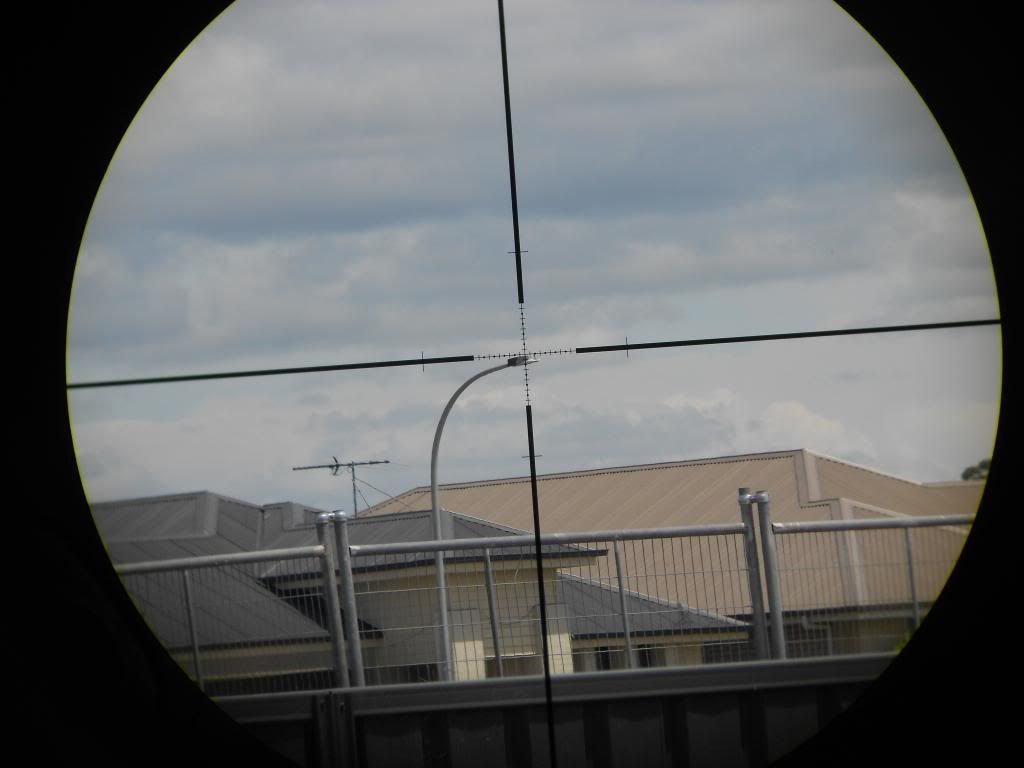
4x Magnification The light post at 150m.
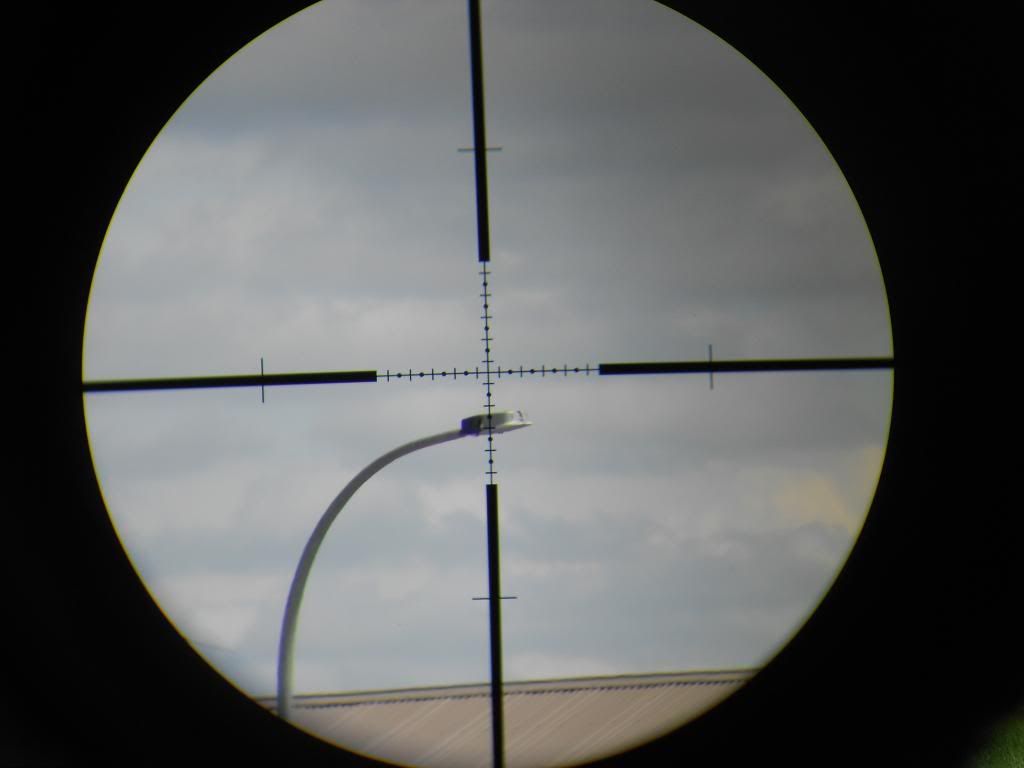
12x Magnification

16x Magnification
In Conclusion, the Steiner 4-16x50 is a great optic with few detractions, The most undesirable in my opinion is the overall length, being a large optic for its magnification range, however this to could be the reason why it performs so well with little optical degradation at the higher magnification ranges. The turrets simplicity of use and the rheostats on/off indentations are standout features of the optic, and while I haven’t used it hammer in tent pegs or abused it by throwing it off a cliff it has performed faultlessly under a number of activities for which the brains trust at Steiner Optik designed and built it for.
Hope you all enjoy,
cheers,
JJ
Initial impressions when you first handle one is that its a monster of a scope and feels quite robust in both construction and function. The Military/Tactical line of riflescopes is Steiner Optik’s entry into the tactical riflescope market released in early 2012, solely focused on the tactical precision shooter. It would seem that the brains trust at Steiner Optik have done their research and identified the critical requirements of the tactical precision rifleman as well as those features of the market leaders in tactical optics such as Schmidt and Bender PMII and a Zeiss Hendsolt that have put them at the top of the apex and packaged it together.
The 4-16x50 is the mid range optic in the Steiner line with 3-12x, 3-15x and 5-25x magnification ranges available, each being identical in external appearance and features.
For more specifics have a browse through the Steiner webpage : www.steiner.de/military/rifle-scopes/04_telescopic-sight-tactical-4-16x50.php
For a great indepth comparison of the Steiner and other market leaders in tactical optics in the same utility range check out Illya's write up here: http://opticsthoughts.com/index.php...s-part-3&catid=4:rifle-scope-reviews&Itemid=4
Initial Observations
Like the majority of todays high end tactical optics the Military/Tacticals are a 34mm tube, and feels quite solidly constructed weighing in at around 970g. The 4-16x50 is quite a long scope, at 41cm long which in perspective is around the same length as the S&B PMII 5-25x56. There is quite a vast amount of tube length in the 4-16 with approximatly 9cm from the ocular to the turret box and 7cm from the turret box to the objective lens angle, providing ample linear movement for gaining an optimum eye relief. This may however also be a concern for those that utilise a Clip on Night Vision Device (CNVD) as the overall length may inhibit the mounting on all but the longest of forward rails such as a full length picatinny railed fore end etc.


Here you can see the size comparison with a Leupold Mk4 3.5-10x40. I should have taken a comparison photo with a PMII 3-12x50 as a closer comparative example however like this whole review/write up idea it was an afterthought and that was all I had on hand.
Controls
The most obvious and attention grabbing feature once you get beyond the overall size are the turrets. As I stated earlier they are monstrous in size with deep machined flutes at the top edge which provides a positive grip for both gloved and bare hands allowing an easy grasp in all conditions. With a total of 32.5 Mrad of internal adjustment, The elevation turret allows for two clockwise revolutions of well marked laser etched .1 Milliradian (Mrad) adjustments in quite precise and definitive clicks, with 10 Mrad of elevation adjustment for the first revolution, and a further 9.5 Mrad on the second rotation for a total of 19.5Mrad of available internal elevation adjustment. The elevation turret features a solid zero stop precisely at the 0 hash mark, as well as visual and dexterous multiple turn indications, the most notable of which is the small ‘double turn indicator’ button the protrudes from below the Elevation turret once it is rotated to the 9.7 Mrad increment. The second revolution doesn’t complete a full 10Mrad due to the design of the zero stop pin and cam for the dual turn indicator button.


Multi Turn visual indicators as well as the spring loaded button protruding.

The elevation turret Internals showing both the double turn cam and the pin inside the turret. As it rotates through its second revolution the pin engages the cam rotating it clockwise allowing the turret to continue through its rotation. I noticed adjustments became slightly stiffer while rotating through this range; my guess is due to the slight force required to cam the button out under spring tension. Not a big deal and barely noticeable as it was still a smooth motion, but noticeable all the same.
The Windage turret is identical in both size and adjustment as the elevation turret, positive crisp .1 Mrad increments marked with both hash marks and numbers at every.5 Mrad. The turret provides 5.0 Mrad of total adjustment in both direction until it comes to a definitive stop. The windage turret is also fitted with a visual multi turn indicator so as to identify how much of the internal lateral adjustment has been used to enable your firearm zero.

The parallax drum, like the Ziess Hendsolt also houses the rheostat for the Illuminated reticle, the parallax is numbered from 50m and then in 100m increments to 1000m and infinity. It was stiff yet smooth to rotate through its full range, providing a secure setting so as not to be easily or inadvertently adjusted form it required setting.
The rheostat and battery housing is a separate smaller turret housed outboard of the parallax drum and allows for 11 brightness settings illuminating the full Fine portion of the reticle. There is an ‘off’ increment in between each brightness enabling a quick switch on/switch off motion as opposed to rotating through the turrets full range of movement, which I one features of the Steiner I like a lot. Brightness settings 1-7 are very light so as to be used in conjunction with a CNVD, while settings 8-11 are daylight visible settings. I did notice that in lowlight conditions there was a degree of blooming and secondary reflection in the tube when using the 9-11 brightness settings, but this was only evident in lowlight. No blooming was observed during daylight conditions.

The magnification adjustment is controlled by a rubber coated ring forward of the ocular housing, it too features the large grippy blocks of the other turrets as well as a raised triangular grip block at the 8x position to aid in rotation. The magnification, like the parallax was stiff yet smooth to adjust through its 180 degree range, a feature Steiner has obviously identified as the middle ground of not easy/ not to tight to aid in any unwanted or inadvertent adjustments. There was no tunnelling of the FOV observed throughout the magnification range.
Reticle
The reticle is positioned in the 1st Focal Plane and is what Steiner have labelled the G2B mildot reticle, which like the Gen 2 Mildot combines the conventional mildots with .5mrad hash marks spaced in between each mildot at the .5 mrad interval. The reticle also has a 2 Mrad hash mark in the thick outer reticle posts at the 10Mrad mark. The reticle is a solid crosshair with a thickness of .06 Mrad, which at 16x is in my opinion on the thick side as it covers smaller targets at distance, in comparison to the P3F and P4F S&B reticles at .03Mrad. The crosshair thickness is on par with the its competitors and is perfectly suitable for the optics intended purpose, however those more inclined to shoot groups may find this thickness less appealing. The reticle and the elevation/windage adjustments tracked and performed faultlessly under a number of exercises, returning to zero after each evolution.
The optical clarity of the Steiner is what one expects of the high end riflescopes, and it is from my eye equal to the S&B PMII’S, good clarity and resolution, however I did notice that the eye box was more forgiving for eye relief and head placement at 12x than at 16x. A yellow ring was also present around the outside edge of the FOV, it was present throughout the magnification range however was most obvious at 16x. Again the usual apologies as these reticle pictures were taken with a handheld point and shoot camera behind the scope so they aren’t the greatest.

4x Magnification The light post at 150m.

12x Magnification

16x Magnification
In Conclusion, the Steiner 4-16x50 is a great optic with few detractions, The most undesirable in my opinion is the overall length, being a large optic for its magnification range, however this to could be the reason why it performs so well with little optical degradation at the higher magnification ranges. The turrets simplicity of use and the rheostats on/off indentations are standout features of the optic, and while I haven’t used it hammer in tent pegs or abused it by throwing it off a cliff it has performed faultlessly under a number of activities for which the brains trust at Steiner Optik designed and built it for.
Hope you all enjoy,
cheers,
JJ

